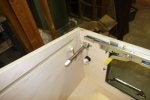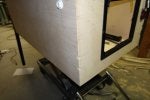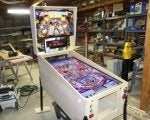One key to using a normal circular saw with any non-track guide is to make sure the edge of the sole plate is parallel to the blade. If it is not, you
will get deflection. If it is parallel then you only need to review your technique to avoid deflection. And if it is too far off parallel, even a track won't help...
First thing I do with a new saw is to use the depth rod on my caliper to measure across the wider side of the sole to a marked tooth on the blade, in two places. if the measurement is the same, it is parallel and good to go. If not, you will need to evaluate your saw to see if there is any way to make it parallel (without messing up the angle adjustability). At the worst, you could add a piece of tempered hardboard or even aluminum to the base and make sure it is parallel to the blade. I have returned a couple of saws right after purchase when they are too far off or if the base flexes too much against a guide. And if you happen to drop your saw, recheck to make sure.
As for technique, I clamp my homemade guide for all cuts, and as much as possible try to operate the saw with both hands so I am not pushing it too hard against or away from the guide. My current saw is also very helpful, a Milwaukee, as the handle can be rotated to position my hand either behind or above the saw. By positioning my hand above the saw, it is harder to twist the saw against the direction of cut, thereby allowing the guide to do it's job. I have tried with my hand behind the saw for more reach across a sheet of ply, and messed up the cut every time.
The other point mentioned in posts above is support. Anything from a sheet of foam board on the ground to a full cutting table can be used. Important is to support the plywood close to the cut along it's full length.
I use a cutting table, followed the plans from Woodsmith for their knock-down cutting table. Supports the sheets completely, and mine is setup so I can just slide plywood from the truck bed right on to the table, make my cuts, then carry the smaller lighter pieces to the shop instead of manhandling full sheets. i posted about it before here, and pics in post # 86 further down.
http://www.woodworkingtalk.com/f27/post-your-favorite-shop-built-tool-jig-fixture-84297/index2/#post877586
And my guides started as 6" wide strips of good 1/2" thick plywood (ripped on the TS) glued to a sheet of 1/8" tempered hardboard, spaced so that I could run the saw down both sides of the strips and make 3 double-sided guides from one sheet. Then cut one guide into 5' and 3' sections for cross cuts, and put one guide away as a backup. When (not if) I manage to make a ding in the edge of the guide, I can run it along the TS fence with the 1/2" ply face down, only cutting through the 1/2" ply. Then run the saw down the guide to make a fresh clean edge again. Once it gets too narrow it starts to deflect easily, so I break out the backup guide.
With careful measurements and setup, I can get some very accurate cuts with my setup. I actually prefer it to trying to get large sheets up on the tablesaw and guide them along a rip fence. And not having that much room in my shop anyway doesn't help either...










